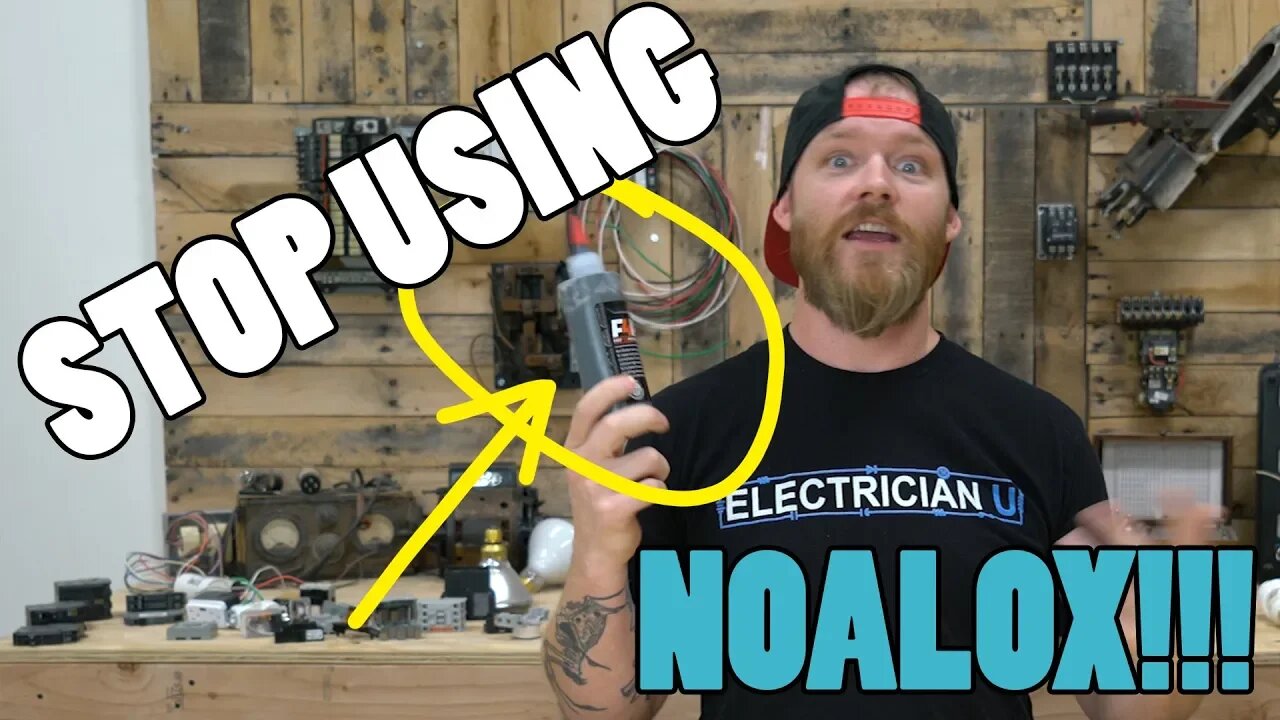Premium Only Content

ELECTRICIANS!!! STOP USING NOALOX INCORRECTLY - putting pookie on aluminum wire
Have you, like me...and many other electricians, been using NOALOX on your aluminum wires for years? We're going to go over why it's not necessary except in specific situations - 4 of them evidently.
👾🤖PRACTICE EXAMS🤖👾
https://www.electricianu.com/practice-exams
😎👕MERCH👕😎
https://www.electricianu.com/merchandise
📲👥SOCIALS👥📲
Instagram - https://www.instagram.com/electrician_u
Discord - https://discord.gg/7ykYfbh
Facebook Page - https://www.facebook.com/theelectricianu
Facebook Group - https://bit.ly/2tz7eQh
TikTok - https://www.tiktok.com/@electricianu
I'm guilty of this too...so let me just get that out there right now. For years I've been dunking conductors in this bottle and getting a fat layer of goop on the ends of my terminations without reading the bottle (manufacturer's specs) about how it's supposed to be used. I've just gone by whatever my boss had told me to do. Most of our bosses, though, have been wiring shit since the beginning of time and if the didn't hear any different, they've just been doing what they've always done.
NOALOX
NOALOX is an anti-oxidizing compound that helps prevent the formation of oxides on the outside of a conductor. No. Aluminum. Oxidization - NO.AL.OX. Before the 60's we'd been using actual aluminum wire for conductors, and the very nature of aluminum is that it's a very reactive material - especially when introduced to air or moisture. It wasn't until the 80's that manufacturers perfected a few alloys to use in wire, that started to curb this issue.
GALVANIC ACTION
Galvanic action occurs when two dissimilar metals come in contact with one another for an extended period of time. It more refers to when an ACTIVE metal comes in contact with a REACTIVE metal. What happens is, over time, these conductors start to "eat away" at one another. Using an anti-oxidizing compound around the conductors helps to minimize this "rusting out" of the conductors where contact is made. This is why a lot of these No-ox brands say "for use with aluminum to copper, and aluminum to aluminum terminations."
AA8800 ALUMINUM
AA8800 aluminum is what's used in MOST of today's aluminum conductors. I did say most, not all. There are some conductors and cables on the market that this is not true for, so you do need to use caution when deciding whether or not your conductor requires the use of a no-ox or de-ox compound. But most conductors used are now made of an alloy (a mixture of metals into a new type of metal) that doesn't react to galvanic action or air and water corrosion like standard aluminum does.
HOW TO APPLY IT
Another thing MOST people do is install this stuff incorrectly to the conductor. There are manufacturer instructions that must be followed when installing almost everything in the electrical trade, because there are codes and standards that require it. The instructions for a lot of these compounds require you to:
1) clean the conductor off with a wire brush or emory cloth
2) apply noalox freely to both the conductor and the connector
3) assemble joint and wipe off the excess
I bet if you did a poll out there and asked all electricians about this method, at least 75% of them have no clue this is required, nor do they do it. The reason for this is that there's no NEC code article that talks about using it or not using it. It's just a commonly-used method, or "rule of thumb." But 110.14 states (paraphrasing here) "where a compound is employed, it must be used correctly," and 110.3(B) says (again...paraphrasing) - any materials used must be used to manufacturer specs/instructions.
CONTINUE READING FULL ARTICLE AT: https://www.electricianu.com/podcast/episode-36-stop-using-noalox-on-aluminum-putting-pookie-on-aluminum-wire
#aluminumwire #noalox #pookie
--
Subscribe - https://www.youtube.com/c/electricianu?sub_confirmation=1
IF YOU ENJOY THESE VIDEOS PLEASE SUBSCRIBE AND "LIKE" THEM ABOVE. ALSO CHECK OUT THE ELECTRICIAN U PODCAST ON ITUNES AND SPOTIFY!!
-
 0:58
0:58
Electrician U
1 year agoFISH STICKS! Every electrician needs these!
6.27K -
 LIVE
LIVE
Badlands Media
9 hours agoBadlands Daily: August 27, 2025
3,361 watching -
 LIVE
LIVE
Law&Crime
1 hour agoLIVE: Adelson Matriarch Murder Trial — FL v. Donna Adelson — Day 4
203 watching -
 LIVE
LIVE
Major League Fishing
5 days agoLIVE! - Fishing Clash Team Series: Challenge Cup - Day 4
118 watching -
 1:03:42
1:03:42
Crypto Power Hour
2 hours agoWhat Coins Are The Backbone of The New Digital Revolution?
6.36K6 -
 LIVE
LIVE
LFA TV
4 hours agoLFA TV ALL DAY STREAM - WEDNESDAY 8/27/25
5,111 watching -
 1:22:55
1:22:55
Game On!
19 hours ago $2.62 earnedBREAKING NFL NEWS: Taylor Swift and Travis Kelce Are Engaged!
39.3K12 -
 41:04
41:04
Coin Stories with Natalie Brunell
1 day agoCooking, Culture & Crypto: Norma Chu’s Food Empire Turns Bitcoin Treasury
35.4K -
 LIVE
LIVE
JuicyJohns
2 hours ago $0.15 earned🟢#1 REBIRTH PLAYER 10.2+ KD🟢
33 watching -
 1:21:19
1:21:19
JULIE GREEN MINISTRIES
3 hours agoDIRTY POLITICIANS WILL BE ARRESTED AND REMOVED FROM POWER
90.3K211